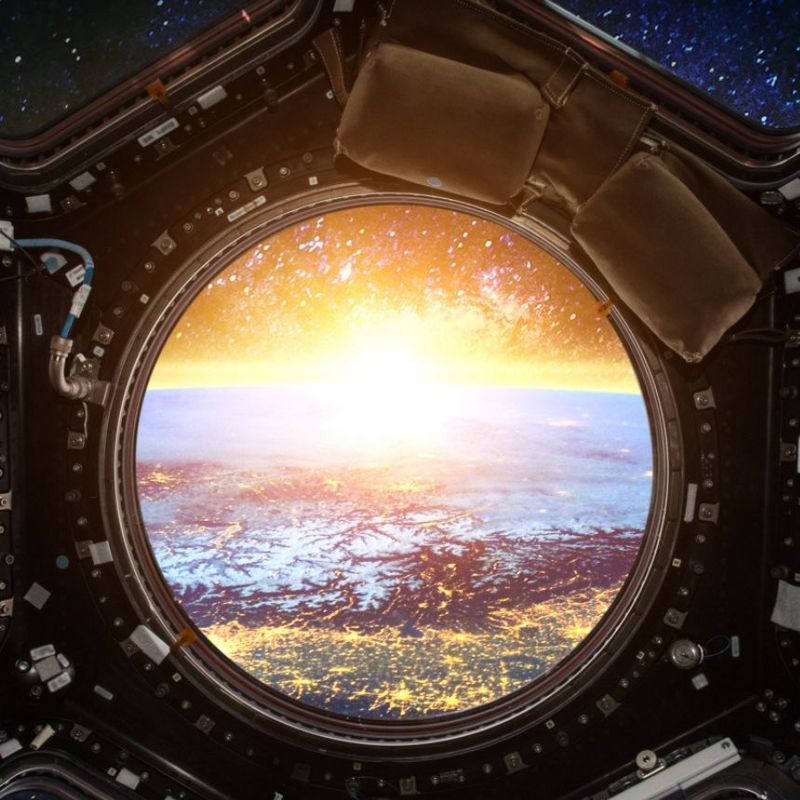7 September 2023
The James Webb Space Telescope circles the Earth at a distance of some 1.5 million kilometres. From this vantage point, its infrared instruments allow it to peer through dust and gases, giving us new insights into the cosmos and its beginnings.
The relatively short history of the James Webb Space Telescope – known as Webb or JWST for short – is a story of superlatives. Originally planned for 2007, its launch into space finally took place on 25 December 2021 after various postponements. 30 days later, the largest and most expensive space telescope to date reached its area of operation: 1.5 million kilometres away from Earth. That’s four times as far as the moon and over 2,700 times farther than the Hubble telescope, which will be succeeded by Webb, itself the joint brainchild of the space agencies of the US, EU and Canada.
Whereas Hubble operates in the visible and ultraviolet light spectrum, the Webb captures the infrared radiation that even the coldest bodies in space emit. To ensure that Webb’s temperature-sensitive sensors are not thrown off by the sun’s heat, the telescope is positioned at the second Lagrange point. It lies on the dark side of the Earth at a distance of 1.5 million kilometres and travels around the sun in the permanent shadow of our planet.
Delivery room of the stars
Webb’s sensors are a hundred times more sensitive than Hubble’s and, because infrared light has a longer wavelength, they can see through the clouds of dust and gas in which stars and planetary systems are born. Until now, researchers have been denied this glimpse into the delivery room of the stars. Webb can also use its instruments to scan the atmospheres of planets outside our solar system specifically for signs of life or the conditions which might support it. Last but not least, Webb is able to capture the faint light from distant stars, thereby allowing it look further into the past than any of its predecessor telescopes. After all, every glimpse into space is a journey through time: When the light from a star 100,000 light-years away reaches our eyes or telescopes, it has been travelling for 100,000 years. So, we get to see this star as it looked 100,000 years ago.
Webb can look back over 13.5 billion years into the past, all the way back to the earliest galaxies to form in the cosmos. This super-telescope should help us find answers to fundamental questions: What did the early universe look like? How do galaxies, planetary systems and black holes form and evolve? Is our Earth unique? Or are there other planets out there which harbour the basic building blocks of life?
A star is born in the Rho Ophiuchi Cloud
One year after the launch of Webb, NASA released an image of the Rho Ophiuchi Cloud in unprecedented detail. This molecular cloud complex is about 390 light-years away, making it the closest region to Earth in which stars form. This region is home to about 50 young stars with a mass similar to that of the Sun. The picture is dominated by huge gas flows, known as jets. These occur when a star first breaks through its “birth shell” of cosmic dust. “Webb's image of Rho Ophiuchi is allowing us to experience a very short period of time in the stellar life cycle with unprecedented clarity,” says Webb project scientist Klaus Pontoppidan. “Our own sun went through a period like this a long time ago, and now we have the technology to see the beginning of another star’s history.”
© NASA ESA CSA STScI K. Pontoppidan A. Pagan_STScIThe image of the Rho Ophiuchi Cloud shows gas flows that are created when a star breaks through its shell of cosmic dust for the first time.
Earendel – the farthest star in the firmament
It was only in spring 2022 that the the Hubble telescope discovered Earendel, the most distant star ever observed: Its light has been travelling towards us for 12.9 billion years. This means that Earendel was created just one billion years after the Big Bang. The Webb telescope has now provided further insights into the star. According to these, it should be twice as hot as our sun and shine a million times brighter. The researchers suspect that Earendel may have a cooler companion star. The discovery of this and other distant stars gives researchers hope that they will eventually find a star of the very first generation. This would consist only of hydrogen and helium – the basic components of the universe that were formed during the Big Bang.
© NASA/ESA/CSA D. Coe AURASTScI for ESA Z. LevayOnly discovered in 2022: Earendel is twice as hot as our sun and shines a million times brighter.
The Pillars of Creation
In the mid-1990s, the Hubble telescope delivered its most famous image to date: Against the backdrop of twinkling stars in the Eagle Nebula, 6,500 light-years away from us, huge structures made of interstellar matter rise up. These are reminiscent of either huge curved fingers or pillars, hence the name given by NASA researchers to this four-light-year-wide star birthplace: “Pillars of Creation”. In 2015, Hubble took a second, higher resolution image. In the meantime, Webb has also turned its attention to the region. In direct comparison to Hubble, its image shows a vast number of stars. Nascent stars appear in pink, red, and purple, while older stars are dressed in blue and yellow. However, these bright colours should not be taken too literally: This is because telescopes like Webb or Hubble don’t take photos in the true sense of the word. Instead, their detectors measure the light emitted by stars or other celestial bodies. In the process, they work with various filters that transmit light in different wavelengths, thus also rendering invisible parts of the spectrum, such as ultraviolet and infrared, visible. These data are stored digitally, initially giving rise to a monochrome image. It is only during post-processing that colours are assigned to the data according to scientific standards to allow details and structures to be distinguished more easily.
Webb’s new and more accurate view of the Pillars of Creation will allow researchers to determine with much greater precision the size of the star population and the amounts of gas and dust in the region. In this way, they will be able to develop an increasingly better understanding of how stars form from these dust and gas clouds over the course of millions of years.
© NASA, ESA, CSA, STScI; J. DePasquale, A. Koekemoer, A. Pagan (STScI)One of the most popular motifs of the James Webb Telescope is known as “The Pillars of Creation”.
Comet 238P/Read and the proof of water
Comets are the dirty snowballs of the universe: They are celestial bodies made of ice and from the dust that once swirled around the young sun. As they approach the Sun on their eccentric orbits, the ice they contain evaporates into gas and forms their characteristic tail. Originally, it was assumed that comets make their home at the frosty edge of our solar system. More recently, it was suggested that water ice may also be present in the warmer asteroid belt between Mars and Jupiter. But there was no proof to support this hypothesis. Webb, however, has been able to deliver this proof for the first time thanks to its precise spectral data. Now it is clear that Comet 238P/Read, which orbits in the asteroid belt, actually evaporates water. This is a scientific breakthrough, because it means that the elemental substance of life can persist inside the solar system. This finding is another piece of the puzzle on the way to answering the big question of how Earth became a water-rich planet. Based on this knowledge, according to the researchers involved, it would then be possible to investigate whether Earth-like celestial bodies might also develop in other planetary systems.
© NASA, ESANew insight thanks to precise spectral data: Comet 238P/Read, which orbits in the asteroid belt, evaporates water.







